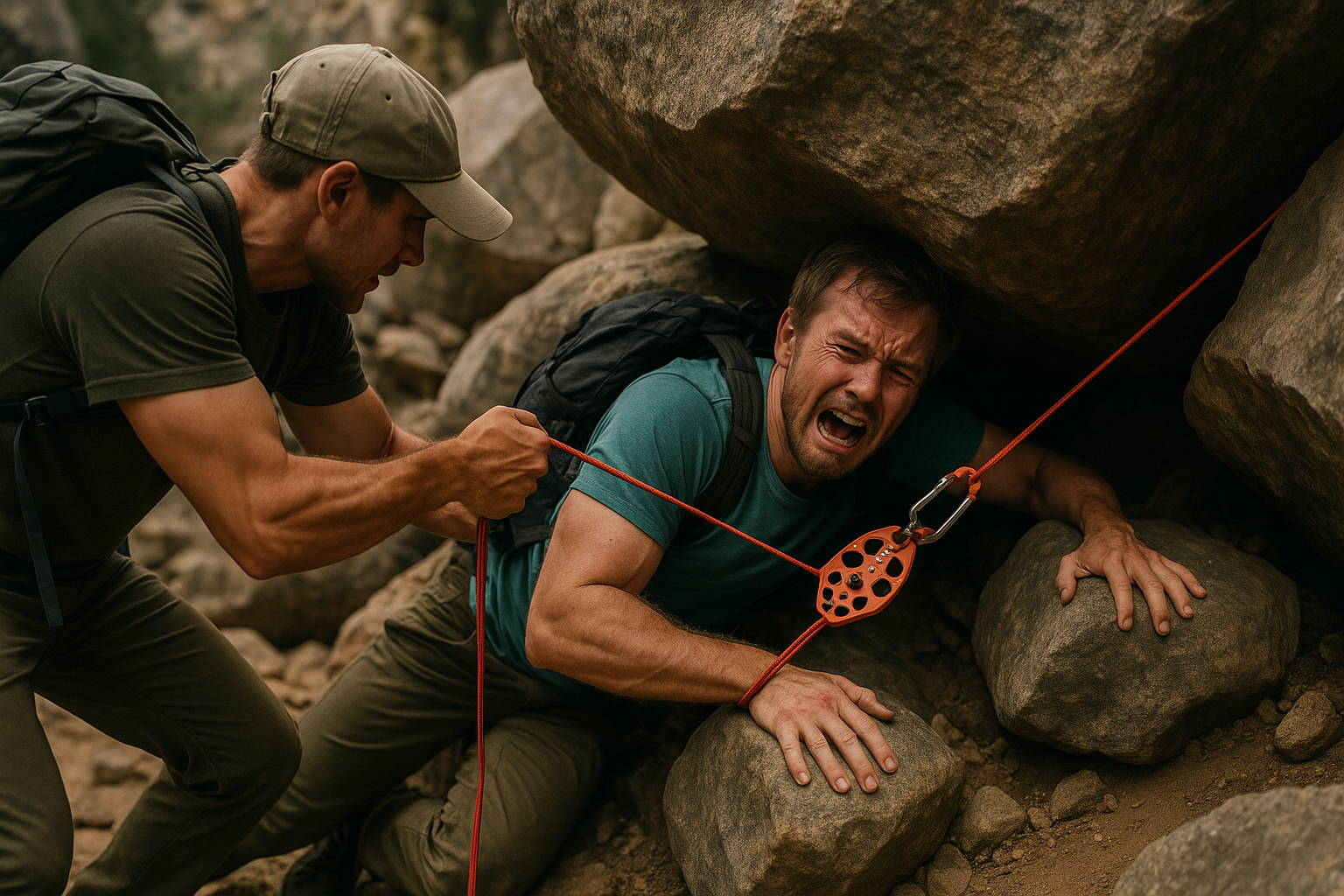It’s You Against the Boulder
It’s a crisp morning. You set off on what was supposed to be an easy day-trek through familiar trails. But an innocent climb up a rocky outcrop turns into a nightmare. The ground shifts beneath your foot, a boulder comes loose, and suddenly you’re pinned. There’s no cell signal, no help coming. The boulder is crushing your leg—and it’s heavier than you imagined possible.
You’re trapped, and time is slipping through your fingers. Panic is rising. But this isn’t the end. With the right ultralight lift gear in your pack, you stand a fighting chance.
Why Standard Gear Won’t Cut It
Forget the typical trekking gear—ropes, carabiners, or sheer muscle power alone won’t budge a boulder pressing you into the earth. Conventional rescue tools are too bulky or ineffective in this real-world scenario. You need compact, field-ready gear designed for this precise emergency—gear that can buy you the minutes you need to escape.
Here’s what ultralight adventurers and survivalists are packing, gear that turns an impossible situation into a shot at survival.
Ultralight Boulder-Lift Arsenal: What to Carry and How to Use It
1️⃣ Miniature Inflatable Air Wedge (Amazon Available)
- How It Works: Slide it under a gap between the boulder and the ground or your trapped limb. Inflate using a hand pump. The wedge exerts lifting force, expanding and creating leverage.
- Why It’s Genius: It weighs ounces, fits in a jacket pocket, and can lift hundreds of pounds with minimal effort.
- Usage Tip: Pre-test at home. Familiarize yourself with how much pressure it can handle and practice one-handed inflation.
2️⃣ Compact Ratcheting Cable Puller (Amazon Available)
- How It Works: This miniaturized, handheld version of a come-along lets you ratchet the cable to generate force, gradually lifting or shifting the boulder.
- Why It’s Genius: Unlike pulleys or winches, it’s self-contained and weighs under 3 pounds. It provides mechanical advantage without complex rigging.
- Usage Tip: Keep a small loop of high-tensile cable (steel or Dyneema) coiled and secured in your pack. Practice anchoring the puller to a tree or rock before relying on it.
3️⃣ Ultralight Collapsible Jack (Amazon Available)
- How It Works: This compact jack can extend and lock to lift surprisingly heavy weights in tight spaces. Think of it as a pocket-sized version of a car jack—but purpose-built for backcountry use.
- Why It’s Genius: It fits into a hydration pouch yet can lift a boulder just enough to free a trapped limb.
- Usage Tip: Look for models with a wide base for stability on uneven ground. Carry a cut piece of tough plastic (like a chopping board) to distribute pressure and prevent sinking.
4️⃣ Kevlar Cord and Friction Hitches
- How It Works: If you’re alone but there’s a sturdy tree or anchor nearby, Kevlar cord can be looped around the boulder with a friction hitch and used as a manual winch.
- Why It’s Genius: Kevlar is ultralight, heat-resistant, and stronger than steel of the same diameter.
- Usage Tip: Always carry at least 20 feet of Kevlar cord. Learn how to tie a Prusik knot or similar friction hitch to create controlled lifting force.
5️⃣ CO₂ Cartridge-Powered Lifter (Amazon Available)
- How It Works: This emergency tool uses compressed CO₂ to rapidly inflate a lifting bladder or airbag. Think of it as the self-rescue equivalent of a car’s airbag.
- Why It’s Genius: It can lift a boulder or heavy object within seconds and weighs under a pound.
- Usage Tip: Keep cartridges separate to avoid accidental discharge. Test before your trek.
Stealthy, Low-Visibility Escape Techniques
When trapped, drawing attention isn’t always safe. If you’re trekking alone in an area with potential risks (wildlife, unstable cliffs), you need silent and minimal-visibility methods. Here’s how:
- Wear muted, natural colors to blend with surroundings.
- Use cordage and wedges that match the terrain’s color—dark greys or browns.
- Avoid high-pitched sounds from whistles or radios unless absolutely necessary.
- Focus on mechanical leverage, not noise, to move the boulder.
Field-Tested Packing Tips
🧭 Always stash mini lift gear in your daypack’s hip belt or exterior pocket.
🎒 Balance weight with other essentials: hydration, first aid, knife.
🔥 Pre-arrange gear into a quick-access pouch—seconds count.
💡 Add a cheat card with lift gear instructions; stress fogs memory.
Real-Life Trekker’s Hack: The “Boot Jack Trick”
In a pinch, your trekking pole or a sturdy branch can act as a crude lever if used with a wedge or ratcheting device. Jam the pole under the boulder at an angle, tie cordage around it for extra tension, and use body weight to generate lift. It’s not ideal—but it buys you precious inches.
Conclusion: Escape Isn’t Luck, It’s Preparation
The nightmare of being pinned under a boulder on a day-trek is real, but it doesn’t have to end in tragedy. With compact, ultralight lift gear—carefully chosen, field-tested, and mentally rehearsed—you’ll have a fighting chance to escape. Pack smart. Train smart. Live to trek another day.

